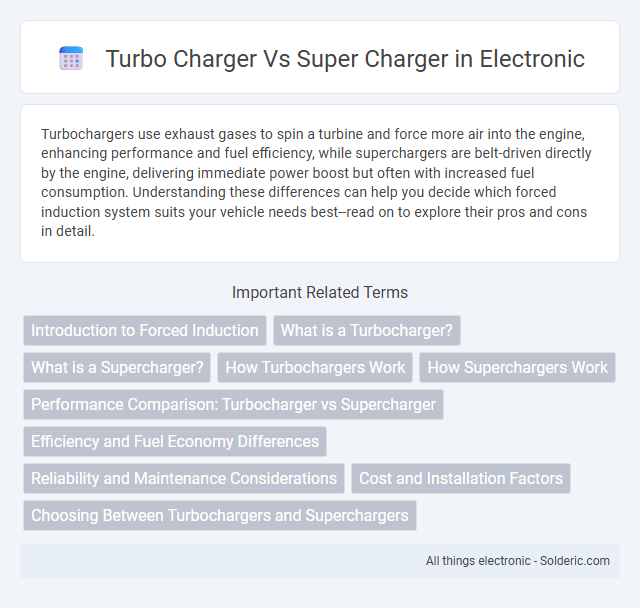Turbochargers use exhaust gases to spin a turbine and force more air into the engine, enhancing performance and fuel efficiency, while superchargers are belt-driven directly by the engine, delivering immediate power boost but often with increased fuel consumption. Understanding these differences can help you decide which forced induction system suits your vehicle needs best--read on to explore their pros and cons in detail.
Comparison Table
| Feature | Turbocharger | Supercharger |
|---|---|---|
| Power Source | Exhaust gas energy | Engine crankshaft via belt |
| Boost Lag | Moderate turbo lag | Instant boost |
| Efficiency | Improves fuel efficiency | Consumes more fuel |
| Installation Complexity | More complex setup | Relatively simpler installation |
| Heat Generation | Generates more heat, needs intercooler | Less heat compared to turbocharger |
| Typical Usage | High-performance, turbocharged vehicles | Muscle cars, immediate power demand |
| Cost | Generally lower cost | Usually higher cost |
Introduction to Forced Induction
Forced induction systems like turbochargers and superchargers increase engine power by compressing air before it enters the combustion chamber, allowing more fuel to burn efficiently. Turbochargers harness exhaust gas energy to spin a turbine and compress intake air, enhancing performance without drawing engine power directly. Superchargers are mechanically driven by the engine's crankshaft, providing immediate boost and consistent power delivery but typically impose a parasitic load.
What is a Turbocharger?
A turbocharger is a forced induction device that increases an engine's efficiency and power output by forcing extra compressed air into the combustion chamber. It uses exhaust gases to spin a turbine connected to a compressor, which boosts air intake without requiring direct engine power. Turbochargers are commonly used in both gasoline and diesel engines to enhance performance and fuel economy.
What is a Supercharger?
A supercharger is a device that forces more air into your engine's combustion chamber, increasing power output by boosting air pressure and density. It is mechanically driven by the engine's crankshaft, providing immediate throttle response without lag, unlike turbochargers that rely on exhaust gases. Superchargers are often preferred for performance vehicles requiring consistent, instant power delivery throughout the RPM range.
How Turbochargers Work
Turbochargers use exhaust gases to spin a turbine connected to a compressor, which forces more air into the engine's cylinders, increasing power and efficiency. This forced induction improves combustion by delivering a higher oxygen concentration, allowing for better fuel burning without significantly increasing engine size. Understanding how turbochargers work can help you optimize your vehicle's performance and fuel economy.
How Superchargers Work
Superchargers work by directly drawing power from the engine's crankshaft through a belt-driven mechanism, forcing more air into the combustion chamber for increased engine power and acceleration. Unlike turbochargers, which use exhaust gases to spin a turbine, superchargers provide instant boost without lag, enhancing throttle response. Understanding how superchargers operate can help you choose the right forced induction system for your vehicle's performance needs.
Performance Comparison: Turbocharger vs Supercharger
Turbochargers deliver improved performance by using exhaust gas to spin a turbine, boosting engine efficiency and power output with better fuel economy. Superchargers provide immediate, consistent boost by mechanically driven compression, offering superior throttle response at lower RPMs but often at the cost of increased fuel consumption. Your choice depends on whether you prioritize instantaneous power delivery or overall engine efficiency and fuel savings.
Efficiency and Fuel Economy Differences
Turbochargers improve efficiency by using exhaust gases to spin a turbine, boosting engine power without significantly increasing fuel consumption. Superchargers draw power directly from the engine, often resulting in higher fuel consumption but providing immediate throttle response. Your choice between the two impacts fuel economy, with turbochargers generally offering better balance between performance and efficiency.
Reliability and Maintenance Considerations
Turbochargers generally offer higher reliability due to their simpler design and reliance on exhaust gases for boost, resulting in fewer moving parts exposed to direct mechanical stress. Superchargers, driven mechanically by the engine via a belt, tend to require more frequent maintenance because of belt wear and additional load on the engine's accessory systems. Understanding these distinctions helps in making informed decisions about performance upgrades and long-term vehicle maintenance costs.
Cost and Installation Factors
Turbochargers generally cost less than superchargers due to their simpler design and use of exhaust gases for power. Installation of turbochargers can be more complex, requiring custom exhaust modifications and intercooling systems, while superchargers often have easier bolt-on installations with fewer adjustments. Maintenance costs tend to be higher for turbos because of their higher operating temperatures and reliance on exhaust components.
Choosing Between Turbochargers and Superchargers
Choosing between turbochargers and superchargers depends on desired engine performance characteristics and driving preferences. Turbochargers use exhaust gas to increase engine power and fuel efficiency by forcing more air into the combustion chamber, often providing better fuel economy but with potential lag. Superchargers are mechanically driven by the engine, delivering immediate boost and throttle response, at the expense of some fuel efficiency due to direct power draw from the engine.
Turbo charger vs super charger Infographic

 solderic.com
solderic.com